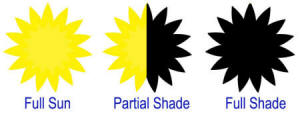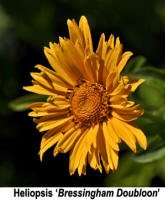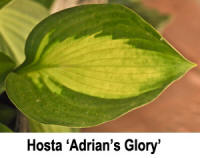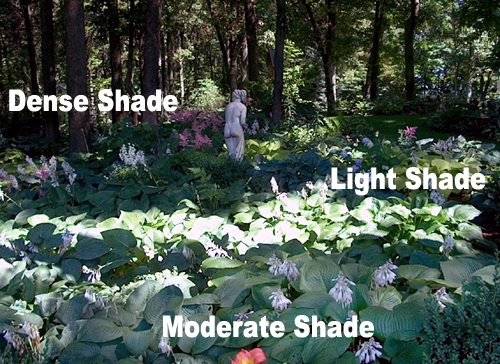In order to do their peak job of
photosynthesis, each species of plant has a certain
ideal level of light that they need. Those that come
from the wide open plains and prairies generally prefer
to have sunlight shining on them the entire day long.
Others that traditionally live in forests or under the
canopies of taller plants can complete their task with
less sunlight. But, they all need light.

A. Full Sun - Most people think that full sun means
that a plant should be exposed to sunlight for 6 to 8
hours per day. Well, in fact, that is just a MINIMUM
number of hours. These are plants that would prefer to
be bathed in sunlight from sunup in the morning until
sundown in the evening. The 6 to 8 hours is just enough
to allow them to get by without any serious
deficiencies.
 Plants that don't get their required minimum amount of
light will soon tell you of their displeasure. They will
grow artificially tall with unusually long spaces
between their branches i.e. internodes. This is called
etiolation and, in its extreme, will cause the plant to
have weakened stems that bend over under the weight of
their foliage or flowers. Also, these plants will not
flower fully and may have lighter colored foliage.
Plants that don't get their required minimum amount of
light will soon tell you of their displeasure. They will
grow artificially tall with unusually long spaces
between their branches i.e. internodes. This is called
etiolation and, in its extreme, will cause the plant to
have weakened stems that bend over under the weight of
their foliage or flowers. Also, these plants will not
flower fully and may have lighter colored foliage.
B. Shade - If full sun plants need at least 6 to 8
hours of sunlight, then by definition, shade plants can
do their thing with less than 6 hours. There is an
unfortunate phrase which is often used in the gardening
trade. Some plants are called “shade loving” which would
imply that they would grow even if you locked them in a
dark closet. We know that is not true since all plants
require a certain level of light for
photosynthesis.
So, a better term for such plants is “shade tolerant.” A
few shade tolerant plants such as highly variegated
hostas with very thin, tissue-like foliage may be
considered "full sun intolerant" due to damage they
sustain in high light conditions but they too need a
certain amount of light to survive and thrive.
The standard way of talking about shade is as if it were
one thing. In reality, there are at least three
categories of shade that we encounter in our gardens.
-
 Light
Shade - In light shade, plants may actually
receive levels approaching those of full sun i.e. six
hours or so. However, that light is spread out over the
entire day where full sun plants need to receive it
in
contiguous hours. As the sun crosses the horizon, plants
in this situation may receive an hour of sunlight here
and a half hour there as the day progresses. This
condition might occur under the lacy leaves of a honeylocust tree or if you just have a few small trees
scattered around your garden.
Light
Shade - In light shade, plants may actually
receive levels approaching those of full sun i.e. six
hours or so. However, that light is spread out over the
entire day where full sun plants need to receive it
in
contiguous hours. As the sun crosses the horizon, plants
in this situation may receive an hour of sunlight here
and a half hour there as the day progresses. This
condition might occur under the lacy leaves of a honeylocust tree or if you just have a few small trees
scattered around your garden.
-
Moderate Shade - The second category would be moderate
or high shade that you often find beneath very large
deciduous trees such as oaks. It is a bright environment
but only rarely due direct sunrays land on the plants
beneath them. You could probably sit and read a book
beneath these trees without any trouble but would only
occasionally be hit by direct sun rays during the course
of the day.
-
Heavy Shade - The last category is dark or heavy
shade. This would occur close to the north side of
buildings or under such trees as pines (Pinus),
spruces (Picea)
or Norway maples (Acer
platanoides) which block most of the light. In
these cases, the plants below only receive light that is
reflected by the surrounding environment.
Needless to say, even those shade
tolerant species like hostas, will respond differently
depending on the level of shade. Generally, they will
thrive in the first two categories but will only be able
to maintain themselves in dark shade situations.
For example, a single division of a
hosta plant placed
in light shade would thrive and add new divisions while
growing at the expected rate over time. In medium shade,
it would also thrive but may add to its clump size at a
slightly slower rate. That same division planted in
dense shade would survive and maintain itself but would
only add new divisions at an extremely slow rate.

We will be addressing the challenges and joys of shade
gardening in a future eBook. The anticipated publishing
date for "A Rookie's Guide to Shade Gardening" would be
autumn in 2015. Another eBook of interest to shade
gardeners would be our, "A
Rookie's Guide to Hostas, Hostas, Hostas".



